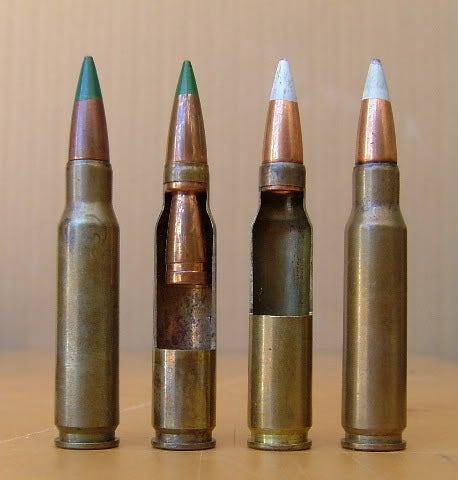After World War II, US Army analysts determined that the effectiveness of the infantryman was not as closely related to their marksmanship discipline as had been previously thought. It seemed that instead, the random environmental circumstances and effects, plus the concealment and movement of the target, had much more of an influence on the probability of a hit than the ability of the shooter to fire his weapon with precision. With this knowledge in hand, arms designers in the West set out to improve the chances of the soldier to hit his target, and the most obvious solution was to simply send more lead downrange. The simplest way to do that was, of course, to create ammunition that fired more than one projectile per round.
Multiplex ammunition has, of course, been around for centuries in the form of shotguns and field artillery that fired multiple round lead balls out of smoothbore barrels, for much the same reason as post-WWII experimental multiplex ammunition. In this way, multiplex ammunition is really an old ammunition concept, not a “future” one at all. Still, the idea of modern standard infantry rifles firing more than one projectile per shot is one that bears considering as part of this series.
First, some terminology: “Multiplex” refers to the concept of firing more than one projectile per shot in general, while the terms “simplex”, “duplex”, “triplex”, quadruplex”, etc refer specifically to rounds firing one, two, three, or four projectiles at once, respectively. “Simplex” technically refers to most modern small arms ammunition, but it’s generally used only in the context of multiplex rounds to denote non-multiplex ammunition, or simplex loads for multiplex firing guns.
In the United States, the multiplex concept has been extensively investigated, and it potentially offers capabilities similar to hyperburst while still facilitating alternative full-power or intermediate-power loads with more range and energy than would be practical with a mechanical hyperburst mechanism. Multiplex ammunition can take the form of multiple high velocity flechettes, dart-firing “beehive” rounds for shotguns that increase their range, full-caliber stacked bore-riding projectiles, or stacked squeezebore projectiles that swage down to a smaller diameter (a concept that will be explored in the next installment). Multiplex rounds can also pack bullets with slightly different shapes, such as different ogives or canted bases, which give the weapon a randomized spread within one pull of the trigger.
Ultimately, multiplex ammunition is more expensive and usually heavier than corresponding ball ammunition of the same size. However, among the advanced concepts this series covers, multiplex rounds are uniquely within reach: The United States even successfully fielded a multiplex 7.62mm rifle round, designated M198, during Vietnam, which had the following characteristics:
Specification – MIL-C-60131 (cancelled in 1980)
Weapon – M14 Rifle and pending for the M60 Machine Gun as of July 1967
Bullets – a) Front bullet weighed 80 to 84 grains, made of B1112 free cutting steel with an electro deposited copper jacket b) Rear bullet weighed 81 to 85 grains, made of B1112 free cutting steel with an electo deposited copper jacket
Velocity – a) Front bullet velocity was 2750 fps + or – 30 fps as measured 78 feet from the muzzle b) Rear bullet velocity was 2200 fps as measured 78 feet from the muzzle.
Accuracy- Front bullet to impact within a 2 ” mean radius at 100 yards
Dispersion – Rear bullet impact was 5 ” to 10 ” CEP at 100 yards
Propellant – 45.5 grains of WC-740
Identification – Front bullet tip was painted Green No. 14110 per FED-STD-595
 Your Privacy Choices
Your Privacy Choices

